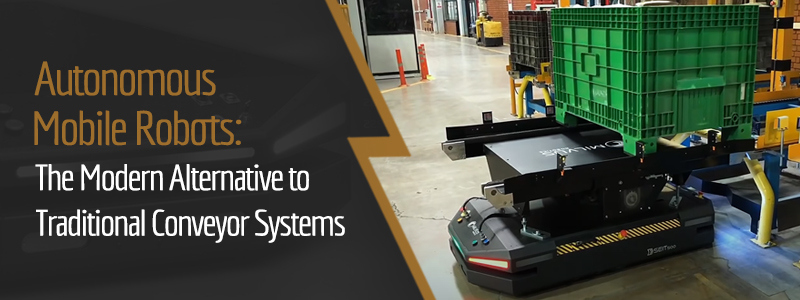Autonomous Mobile Robots: The Modern Alternative to Traditional Conveyor Systems

Conveyor systems are an integral part of most manufacturing and distribution centers across the globe. As a reliable way to deliver materials throughout a facility, it’s unsurprising that conveyors are still in widespread use. But for some facilities, it makes sense to implement a more flexible solution – one that works for a wider variety of applications beyond delivering materials along a set route.
Autonomous mobile robots (AMRs) are an excellent and high-tech alternative to traditional conveyors. Like conveyor systems, they’re able to transport materials of all shapes and sizes from one point to the next in manufacturing or distribution facilities. They’re also capable of much more! When equipped with various attachments, AMRs can deliver, load, and unload materials with little to no human intervention. Productivity and safety increase while labor costs decrease.
Here are some of the reasons why companies are using AMRs as a value-added alternative to standard conveyor systems.
AMRs Offer Multifaceted Flexibility and Adaptability
In an ever-changing environment such as a warehouse or production facility, AMRs provide incredible flexibility. Conveyor systems are not very flexible, as it is often difficult and costly to change routes, not to mention the cost of installing them in the first place. With an AMR fleet, you can quickly adjust routes or make improvements to material flow at any time – with little to no cost. AMRs make it simple to reconfigure routes if you are making logistics changes. At any point on their routes, the robots can detect objects or people in their path and either maneuver around them or find an alternate route to their destination.
AMRs May Reduce the Risk of Accidents and Injuries
Conveyor systems can cause danger to nearby operators, as they are designed to move constantly. Falling objects or malfunctioning parts may lead to injury. But with their autonomous sensing capabilities, AMRs can detect any obstacle in their path and avoid colliding with it. AMRs are safe for use around people, so there is no need for a human exclusion zone along their delivery routes. They can also navigate around other equipment, like forklifts. Additionally, when AMRs are used to load and unload heavy pallets, the need for human labor is reduced and thus it is less likely for employees to get injured while moving heavy items.
You Can Implement AMRs Rapidly
Making permanent modifications to your facility’s infrastructure may cause costly downtime. Conveyor systems are typically large and time-consuming to install. One of the most attractive things about AMRs is that they can be implemented right away, regardless of the existing layout of your facility. At Milvus Robotics, we take your existing facility into careful consideration when helping you to develop a solution. Our robots can maneuver around various obstacles and deliver materials safely and efficiently, even in a changing environment. They can be deployed in just a few hours and get straight to work.
There’s Less Risk of Downtime with AMRs
A malfunctioning conveyor system can bring the logistics process to a halt until a solution is reached. Even if just one element is damaged or requires maintenance, the entire line will be slowed down or stopped. With an AMR fleet, if one robot requires repairs or maintenance, its tasks can be immediately assigned to another robot to minimize downtime and ensure a continuous cycle. Fully automated material handling also reduces the risk of time-wasting human error.
Both conveyor systems and AMRs have their place. But if you’re finding that you need a high level of flexibility, safety, and rapid implementation without infrastructure changes, then AMRs may be the perfect solution. Browse the Milvus Robotics lineup of autonomous mobile robots or contact us today to learn more.